
Do you have a question about the Dräger Infinity Delta XL and is the answer not in the manual?
| Resolution | 800 x 600 pixels |
|---|---|
| Battery Type | Lithium-ion |
| Display Type | TFT LCD |
| Weight | 6.7 kg |
| Power Supply | 100-240 V AC, 50/60 Hz |
| Battery Life | 2 hours |
| Connectivity | Ethernet, USB |
| Monitoring Parameters | ECG, SpO2, NIBP, Temperature, Respiration |
| Alarms | Audible and visual alarms |
| Data Storage | Internal memory for trend data and events, external storage via USB |
Specifies the intended application of the Infinity Delta Series monitors for multi-parameter patient monitoring.
Lists the physiological parameters that Infinity Delta series monitors are capable of monitoring.
Outlines essential safety precautions for operating the patient monitoring equipment safely and accurately.
Describes how to configure the monitor and offers tips on software upgrades and saving/restoring setups.
Explains how to save and restore patient and monitoring settings, including naming and renaming setups.
Details the process of connecting the monitor to a network via the Infinity Docking Station (IDS) or DirectNet.
Guides the user on how to enter and edit patient demographic data at the bedside monitor or central station.
Explains how to configure alarm limits and how the monitor alerts users to limit violations.
Describes the three alarm priorities (high, medium, low) and their associated auditory signals and colors.
Covers suspending alarms using fixed keys, including All Alarms Off and Alarm Silence functions.
Details how to modify alarm limits for multiple parameters in a single location.
Guides the user on how to customize trend functions, including display mode and channel assignment.
Describes how trend graphs display stored data in individual graphs, showing parameter behavior over time.
Details how to customize various recorder functions, including delay, duration, and speed.
Provides general precautions for safe ECG monitoring, including warnings about strip recordings and evoked potential devices.
Details how the monitor identifies pacer pulses and the settings for enabling/disabling pacer detection.
Emphasizes careful skin preparation and proper electrode placement for strong signals with minimal artifact.
Describes how to access and configure ECG settings, including lead selection, size, and processing.
Details how the monitor learns a patient's reference template based on QRS pattern identification for arrhythmia analysis.
Guides on configuring arrhythmia monitoring by selecting modes (Full, Basic, OFF) and lead selections.
Provides a table to configure arrhythmia monitoring, allowing modification of event attributes and settings.
Details the ST analysis menu for executing functions related to analyzing the ST segment.
Explains how to adjust the isoelectric and ST measuring points for accurate ST deviation measurement.
Allows modification of alarm limits for multiple ST parameters and execution of alarm functions.
Explains how to access and configure EEG channels, lead labels, size, and options.
Provides safety precautions for respiration measurement, including warnings about apnea detection and ESU interference.
Details how to control impedance respiration functions via the RESP setup menu.
Covers safety considerations, cuff pressure cutoffs, and cuff selection/placement for NBP monitoring.
Highlights warnings regarding cuff inflation/deflation, limb placement, and accurate measurement dependence.
Emphasizes selecting the correct cuff size for the patient's limb circumference for accurate NBP monitoring.
Describes functions available on the NBP menu, including interval time, venous stasis, and inflation limits.
Details procedures for performing single, interval, and continuous NBP measurements.
Details the two-phase process for IBP setup, including parameter configuration and assignment to channels.
Explains how to assign pressure labels to channels and the color-coding system.
Provides recommendations for optimizing cardiac output measurement accuracy, including injectate handling and verification.
Illustrates a typical cardiac output setup using the HemoMed pod and lists available components.
Details procedures for measuring cardiac output in both automatic and manual modes.
Explains how to review and average up to five measurements to compensate for injection technique variations.
Explains how to calculate and store hemodynamic, oxygenation, and ventilation parameters.
Lists and defines the hemodynamic parameters calculated by the monitor, including their derivation and units.
Describes how the monitor calculates infusion rates for drugs and displays titration tables.
Guides on connecting Masimo SET, Nellcor Oximax, and other compatible SpO2 sensors.
Explains how to access and configure SpO2 settings, including pulse tone source, waveform size, and averaging.
Details the process for calibrating the sensor, including installing the gas cylinder and connecting the sensor.
Covers setting sensor application time and temperature, and influences of barometric pressure.
Provides general safety precautions for etCO2 and gas analysis, including warnings on apnea detection and tubing connections.
Details mainstream and sidestream sampling methods for etCO2 monitoring.
Guides on accessing and configuring etCO2 setup menus for the Microstream pod.
Covers configuring the monitor to display airway pressure (Paw) and flow/volume (Vent) parameters.
Guides on connecting the pod to the sensor and accessing the FiO2 menu for calibration.
Details the two types of calibration (1-point and 2-point) and when they should be performed.
Describes how Scio parameters are displayed and configured, including etCO2 monitoring and agent identification.
Guides on starting, stopping, and clearing NMT measurements, including setting alarm limits.
Lists precautions for BIS monitoring, emphasizing clinical judgment and cautious interpretation of values.
Emphasizes careful skin preparation and sensor placement for strong signals with minimal artifact.
Explains how to access the BIS setup menu and check sensor impedance.
Explains how the PiCCO pod monitors cardiopulmonary and circulatory variables, determining cardiac output.
Lists warnings and cautions for PiCCO monitoring, including catheter placement and patient data input.
Guides on entering patient information and setting up the PiCCO pod and hardware, including IBP connection.
Details how to access and configure PiCCO parameters for Pulse Contour Analysis and Transpulmonary Thermodilution.
Guides on accessing the temperature setup menu to configure TEMP display and alarms.
Provides general instructions for cleaning and disinfecting the monitor and peripherals per hospital protocol.
Provides information on electromagnetic compatibility for the Dräger Delta series monitors.
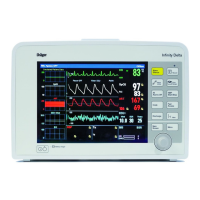



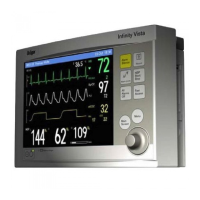

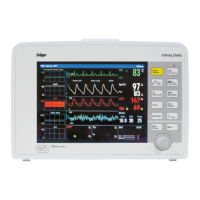
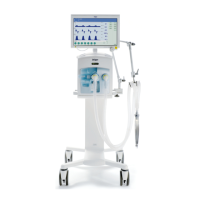
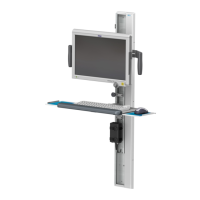

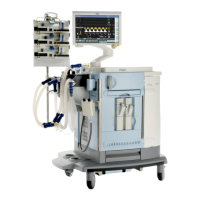
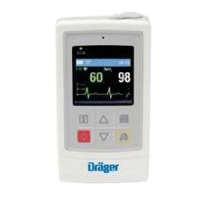
